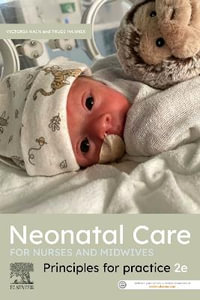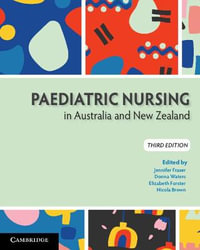
Fundamentals of Pharmacology for Children's Nurses
By: Ian Peate (Editor), Peter Dryden (Editor)
Paperback | 3 January 2022 | Edition Number 1
At a Glance
448 Pages
25.5 x 17.8 x 2.3
Paperback
RRP $74.95
$49.35
34%OFF
or 4 interest-free payments of $12.34 with
orAims to ship in 7 to 10 business days
Fundamentals of Pharmacology for Children's Nurses is written for nurses and allied health professionals involved in the care of children and young people (CYP) to focus exclusively on pharmacology. Filling a gap in current literature on the subject, this much-needed resource develops the competence and confidence required to prescribe, dispense, and administer medicines to children and young people.
Emphasising the importance of patient-centered care to CYP, the text describes the role of the healthcare provider working with CYP and their families; explains how to use pharmaceutical and prescribing reference guides; discusses legal and ethical issues; examines pharmacodynamics and pharmacokinetics, and more.
Helping readers respond appropriately and compassionately to the needs of those receiving care and their families, this textbook:
- Covers a wide range of medications used in diabetes, cancer, mental health, and other areas
- Features a wealth of full-colour images and numerous pedagogical tools including learning objectives, self-test questions, and reflective exercises to enable readers to contextualise and assess their knowledge Presents case studies to reinforce learning, and illustrate the application of theory to practice
- Provides authoritative and practical guidance on formulations, adverse drug reactions, analgesics, antibiotics, immunisations, and the medications most commonly used when providing care to CYP
- Includes access to a companion website with interactive MCQs, case studies, references, an image bank, and links to further reading and supplemental resources
Contributors xv
Preface xxv
Acknowledgements xxvii
Prefixes and Suffixes xxix
Abbreviations xli
About the Companion Website xliii
1 Introduction to Pharmacology, Children and Young People 1
Introduction to Pharmacology 2
Professional Framework 2
The Importance and Value of Medicine Within Healthcare 3
Therapeutic Pharmacology 3
Social Prescribing 4
Safety Within Paediatric Care 5
Medicines Optimisation 5
Medicines 6
Medicine Management 6
Safety: Rights of Medication Administration 7
Specific Considerations for Babies, Children and Young People 7
Infancy 7
Adolescents 9
Tablets 10
Distraction Techniques 10
Conclusion 11
Glossary 11
References 12
Further Resources 12
Multiple Choice Questions 13
Find Out More 14
2 How to Use Pharmaceutical and Prescribing Reference Guides 17
Introduction 18
The British National Formulary and the British National Formulary for Children 19
Paper Copy BNFc 19
How to navigate the BNFc 19
Online and Mobile Application BNFc 23
Monthly Index of Medical Specialities (MIMS) 24
Electronic Medicines Compendium 26
What can be Prescribed on an NHS Prescription? 26
Other Guides to Prescribing 27
The Evidence Base to Prescribing: Prescribing Guidelines 28
Conclusion 30
References 30
Further Resources 30
Multiple Choice Questions 30
3 Legal and Ethical Issues 33
Introduction 34
The Law 34
The Bolam Test 35
The Children Act 2004 36
Duty of Care and Healthcare 37
Regulation of Healthcare 37
Ethical Principles and Theories 38
Research 39
Children and Young People who are under 16 years – Gillick and Fraser Guidance 42
Assessing and Promoting Competence 42
Parental Responsibility 43
Medication Adherence and Administration 43
Conclusion 44
References 45
Further Resources 47
Multiple Choice Questions 47
Find Out More 48
4 Medicines Management and the Role of the Healthcare Provider Working with Children, Young People and Families 49
Introduction 50
Being an Accountable Professional 51
Nursing and Midwifery Council 51
Employer and Colleagues 51
Promoting Health and Preventing Ill Health 52
Holistic Assessment 52
Assessing Needs and Planning Care 53
Self?Medication 55
Complementary and Alternative Medication (CAM) 58
Planning 58
Providing and Evaluating Care 58
Checking 59
Evaluation 59
Leading and Managing Nursing Care and Working in Teams 60
Improving Safety and Quality 62
Coordinating Care 63
Conclusion 65
References 65
Further Resources 66
Multiple Choice Questions 66
Find Out More 68
5 Pharmacodynamics and Pharmacokinetics 69
Introduction 70
Royal Pharmaceutical Society 70
The Nursing and Midwifery Council 70
Pharmacokinetics 70
Think Paediatrics 79
Pharmacodynamics 81
Conclusion 85
Glossary 85
References 85
Further Resources 87
Multiple Choice Questions 87
6 Drug Formulations 89
Introduction 90
Licensing of Paediatric Medicines 90
Types of Formulations 91
Excipients 96
Enteral Feeding Tubes 97
Displacement Values 100
Conclusion 101
Glossary 101
References 101
Further Resources 103
Multiple Choice Questions 103
Find Out More 105
7 Medications Used in the Cardiovascular System 107
Introduction 108
Gross Anatomy Related to Cardiovascular System (CVS) Pharmacology 108
Cardiovascular Drugs Affecting Chronic Conditions 110
Anticoagulant Medications 112
Angiotensin Converting Enzyme (ACE) Inhibitors 113
Angiotensin II Receptor Antagonists 114
Peripheral Alpha Antagonist or Alpha?Adrenergic Blockers: ‘Alpha Blockers’ 114
Cardiovascular Drugs for Use in Acute Clinical Scenarios 114
Electrophysiological System Recap 114
Drugs with an Inotropic Effect 117
Drugs with a Chronotropic Effect 121
Conclusion 123
Glossary 124
References 124
Further Resources 125
Multiple Choice Questions 126
Find Out More 127
8 Medications Used in the Renal System 129
Introduction 130
Anatomy and Physiology of the Renal System 130
Common Renal Conditions 132
Nephrotic Syndrome 132
Treatment of MCNS 134
Drugs Used to Treat Electrolyte Disorders 138
Conclusion 145
Glossary 145
References 146
Further Resources 147
Multiple Choice Questions 148
Find Out More 149
9 Medications Used in the Endocrine System 151
Introduction 152
The Endocrine System 152
Medications Used in Endocrine Disorders Affecting Growth 154
Endocrine Disorders of Puberty 157
Drugs Used to Block Puberty or the Action of Sex Steroids 160
Drugs Used to Reduce the Action of Sex Steroids 161
Medications Used in Disorders of the Adrenal Glands 162
Medications Used in the Management of Diabetes 163
Conclusion 163
Glossary 169
References 169
Further Resources 170
Multiple Choice Questions 170
Find Out More 172
10 Medications Used in the Respiratory System 173
Introduction 174
Asthma 175
Croup 177
Bronchiolitis 178
Pneumonia 178
Cystic Fibrosis 179
Respiratory Medicines 180
Antibiotics 187
Mucolytics 188
Other Respiratory Drugs 188
Conclusion 189
Glossary 190
References 190
Further Resources 191
Multiple Choice Questions 191
Find Out More 192
11 Medications Used in the Gastrointestinal System 195
Introduction 196
Overview of the Anatomy and Physiology of the Gastrointestinal System 196
The Stomach 197
Small Intestines 198
The Liver 199
The Gallbladder 199
The Pancreas 199
The Large Intestine 199
Gastro?Oesophageal Reflux Disease (GORD) 200
Enteral Feeding Tubes and Medication Administration 204
Constipation 208
Crohn’s Disease 211
Conclusion 214
Glossary 214
References 215
Further Resources 216
Multiple Choice Questions 216
Find Out More 218
12 Medications Used in the Nervous System 219
Introduction 220
Epilepsy 221
Guillain–Barre Syndrome 228
Migraine 230
Status Migrainosus 234
Conclusion 234
Glossary 234
References 234
Further Resources 237
Multiple Choice Questions 237
Appendix 1: AEDs Used in Treatment of Childhood Epilepsy 239
13 The Immune System and Immunisations 241
Introduction 242
Types of Immunity 242
How Immunisations Work 243
Immunisation and Public Health 245
Immunisation Schedule 246
Vaccine Uptake 246
The ‘Cold Chain’ 248
Patient Specific Directions and Patient Group Directives 248
Administration of Vaccines 248
Common Reactions and Anaphylaxis 250
Communication with the Child and Family 251
The Green Book 252
Conclusion 252
Glossary 252
References 252
Further Resources 253
Multiple Choice Questions 253
Find Out More 255
14 Medications and the Integumentary System 257
Introduction 258
Anatomy and Physiology of the Integumentary System 258
The Epidermis 258
Common Skin Conditions 259
Conclusion 270
Glossary 271
References 271
Further Resources 272
Multiple Choice Questions 272
Find Out More 274
15 Medications Used in Children and Young People’s Mental Health 275
Introduction 276
What Is Psychopharmacology? 276
Medications 276
Conclusion 288
Glossary 288
References 289
Further Resources 290
Multiple Choice Questions 291
Find Out More 292
16 Medications Used in Children and Young People’s cancer 293
Introduction 294
Cancer 294
Cell Cycle 295
Chemotherapies 296
Immunotherapies in Treating Cancer 301
Corticosteroid Use in Cancer 308
Conclusion 312
Glossary 312
References 312
Further Resources 314
Multiple Choice Questions 314
Find Out More 316
17 Analgesics 317
Introduction 318
Pain Pathways 318
Definitions and Categories of Pain 319
Importance of Individualised Pain Assessments 320
Assessment Tools 321
Multimodal Management Strategies 323
Pharmacological Management 324
Non?opioids 325
Non-Steroidal Anti-Inflammatory Drugs (NAIDs) 327
Opioid Agonists 327
Codeine Phosphate 331
Dihydrocodeine 331
Tramadol 331
Morphine 332
Fentanyl 332
Adjuvants and Co?analgesics – Gabapentinoids 333
Inhalation Analgesics 333
Local, Regional and Topical Analgesia 334
Conclusion 337
Glossary 337
References 338
Further Resources 340
Multiple Choice Questions 341
Find Out More 342
18 Antimicrobial Medications 343
Introduction 344
Microorganisms 344
Antimicrobial Medications 345
Antibacterial Medications 345
Penicillins 347
Antiviral Medications 351
Antifungal Medications 354
Antiprotozoal Medications 357
Antimicrobial Resistance 359
Antimicrobial Stewardship 360
Prescribing Antimicrobials 362
Conclusion 362
Glossary 363
References 363
Further Resources 364
Multiple Choice Questions 365
Find Out More 366
19 Adverse Drug Reactions 367
Introduction 368
Adverse Events 369
Side Effects 369
Preventing ADRs 370
Recognising ADRs 371
ADRs and Immunisations 372
Allergic Reactions 373
Anaphylaxis 373
Medicines Safety and Reporting ADRs 376
Reporting ADRs via The Yellow Card System 377
Conclusion 379
References 379
Further Resources 380
Multiple Choice Questions 380
Answers 383
Index 387
ISBN: 9781119633211
ISBN-10: 1119633214
Series: Fundamentals
Published: 3rd January 2022
Format: Paperback
Language: English
Number of Pages: 448
Audience: Professional and Scholarly
Publisher: John Wiley & Sons (UK)
Country of Publication: US
Edition Number: 1
Dimensions (cm): 25.5 x 17.8 x 2.3
Weight (kg): 0.94
Shipping
| Standard Shipping | Express Shipping | |
|---|---|---|
| Metro postcodes: | $9.99 | $14.95 |
| Regional postcodes: | $9.99 | $14.95 |
| Rural postcodes: | $9.99 | $14.95 |
How to return your order
At Booktopia, we offer hassle-free returns in accordance with our returns policy. If you wish to return an item, please get in touch with Booktopia Customer Care.
Additional postage charges may be applicable.
Defective items
If there is a problem with any of the items received for your order then the Booktopia Customer Care team is ready to assist you.
For more info please visit our Help Centre.
You Can Find This Book In

Life Skills Progression 2/e
An Outcome and Intervention Planning Instrument for Use with Families at Risk
Paperback
RRP $130.00
$105.90
OFF

Goldsmith's Assisted Ventilation of the Neonate
7th Edition - An Evidence-Based Approach to Newborn Respiratory Care
Hardcover
RRP $189.95
$133.50
OFF





















